2011 HYUNDAI TUCSON tow
[x] Cancel search: towPage 12 of 382
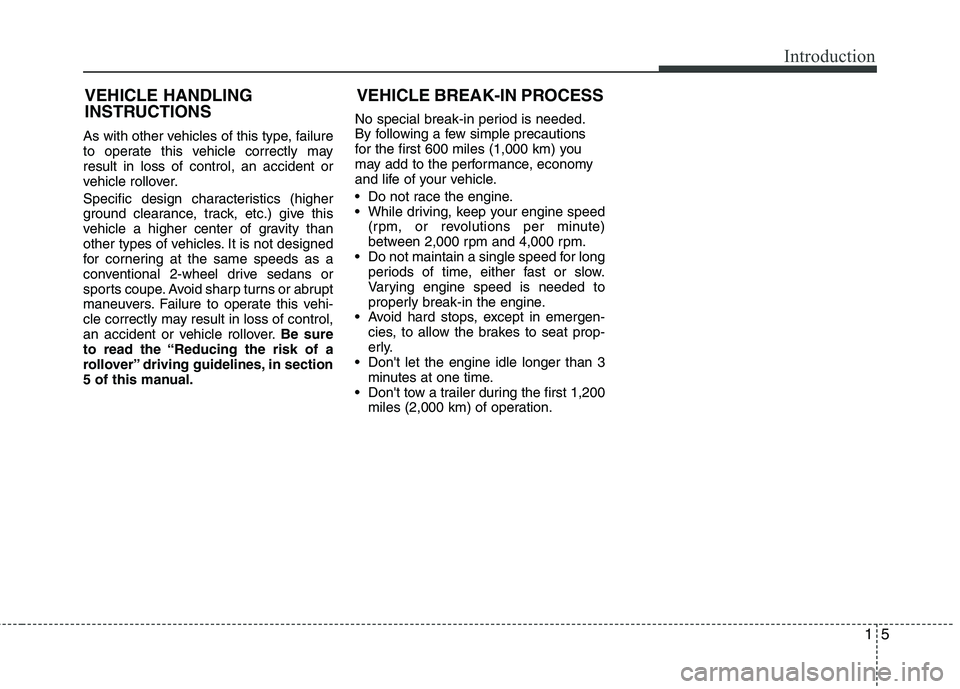
15
Introduction
As with other vehicles of this type, failure
to operate this vehicle correctly mayresult in loss of control, an accident or
vehicle rollover.
Specific design characteristics (higher
ground clearance, track, etc.) give this
vehicle a higher center of gravity than
other types of vehicles. It is not designed
for cornering at the same speeds as a
conventional 2-wheel drive sedans or
sports coupe. Avoid sharp turns or abrupt
maneuvers. Failure to operate this vehi-
cle correctly may result in loss of control,
an accident or vehicle rollover.Be sure
to read the “Reducing the risk of a
rollover” driving guidelines, in section
5 of this manual. No special break-in period is needed.
By following a few simple precautions
for the first 600 miles (1,000 km) you
may add to the performance, economy
and life of your vehicle.
Do not race the engine.
While driving, keep your engine speed
(rpm, or revolutions per minute)
between 2,000 rpm and 4,000 rpm.
Do not maintain a single speed for long periods of time, either fast or slow.
Varying engine speed is needed to
properly break-in the engine.
Avoid hard stops, except in emergen- cies, to allow the brakes to seat prop-
erly.
Don't let the engine idle longer than 3 minutes at one time.
Don't tow a trailer during the first 1,200
miles (2,000 km) of operation.
VEHICLE BREAK-IN PROCESS
VEHICLE HANDLING
INSTRUCTIONS
Page 32 of 382
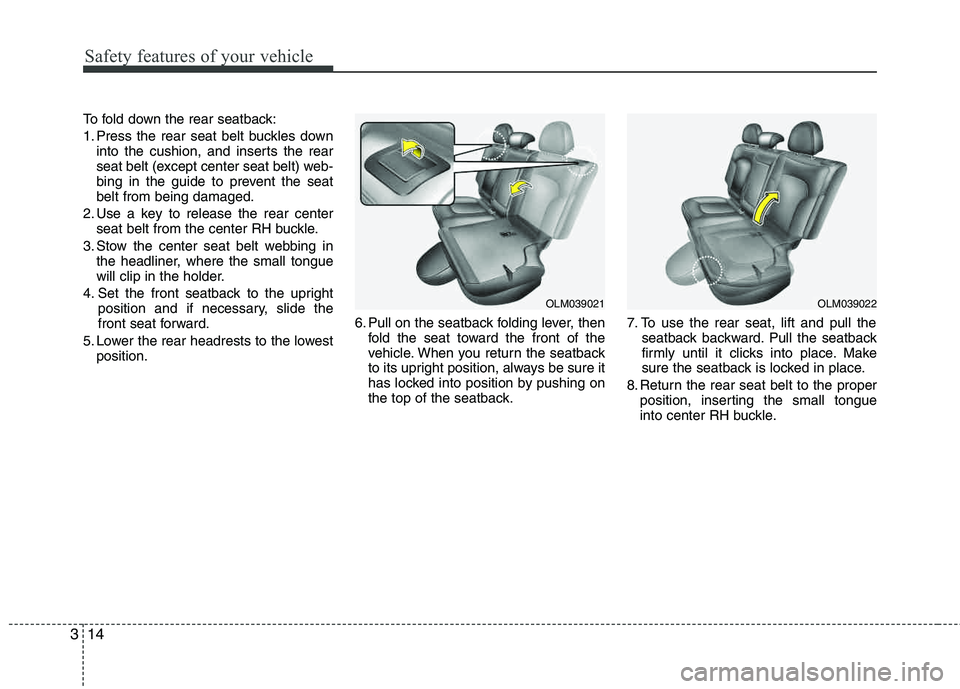
Safety features of your vehicle
14
3
To fold down the rear seatback:
1. Press the rear seat belt buckles down
into the cushion, and inserts the rear
seat belt (except center seat belt) web-
bing in the guide to prevent the seat belt from being damaged.
2. Use a key to release the rear center seat belt from the center RH buckle.
3. Stow the center seat belt webbing in the headliner, where the small tongue
will clip in the holder.
4. Set the front seatback to the upright position and if necessary, slide the
front seat forward.
5. Lower the rear headrests to the lowest position. 6. Pull on the seatback folding lever, then
fold the seat toward the front of the
vehicle. When you return the seatback
to its upright position, always be sure it
has locked into position by pushing on
the top of the seatback. 7. To use the rear seat, lift and pull the
seatback backward. Pull the seatback
firmly until it clicks into place. Make
sure the seatback is locked in place.
8. Return the rear seat belt to the proper position, inserting the small tongue
into center RH buckle.
OLM039021OLM039022
Page 41 of 382
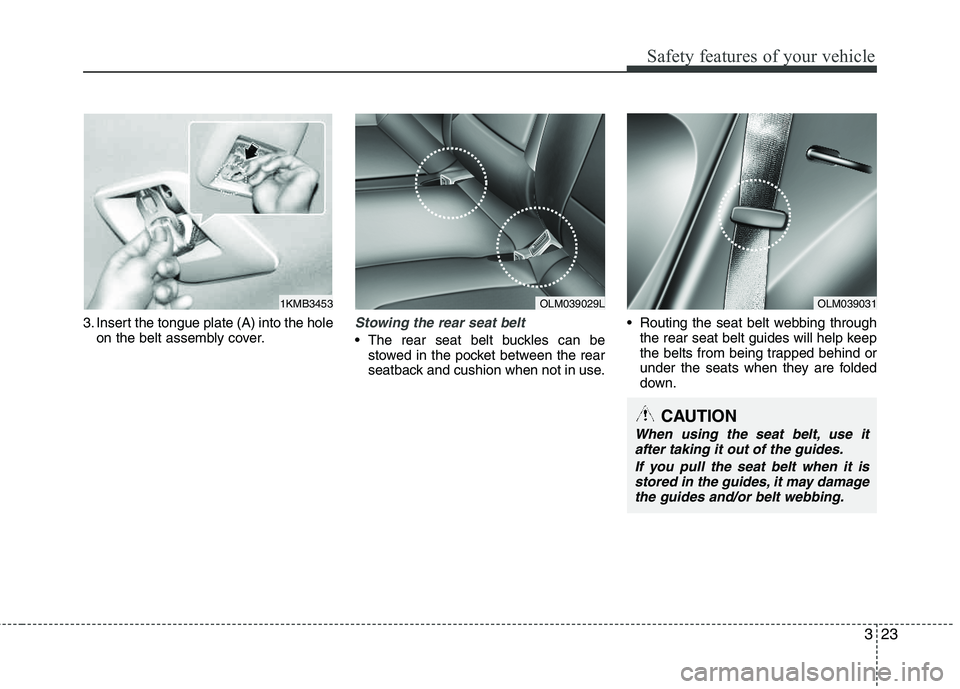
323
Safety features of your vehicle
3. Insert the tongue plate (A) into the holeon the belt assembly cover.Stowing the rear seat belt
The rear seat belt buckles can bestowed in the pocket between the rear
seatback and cushion when not in use. Routing the seat belt webbing through
the rear seat belt guides will help keep
the belts from being trapped behind or
under the seats when they are folded
down.
1KMB3453OLM039029LOLM039031
CAUTION
When using the seat belt, use it
after taking it out of the guides.
If you pull the seat belt when it isstored in the guides, it may damagethe guides and/or belt webbing.
Page 52 of 382
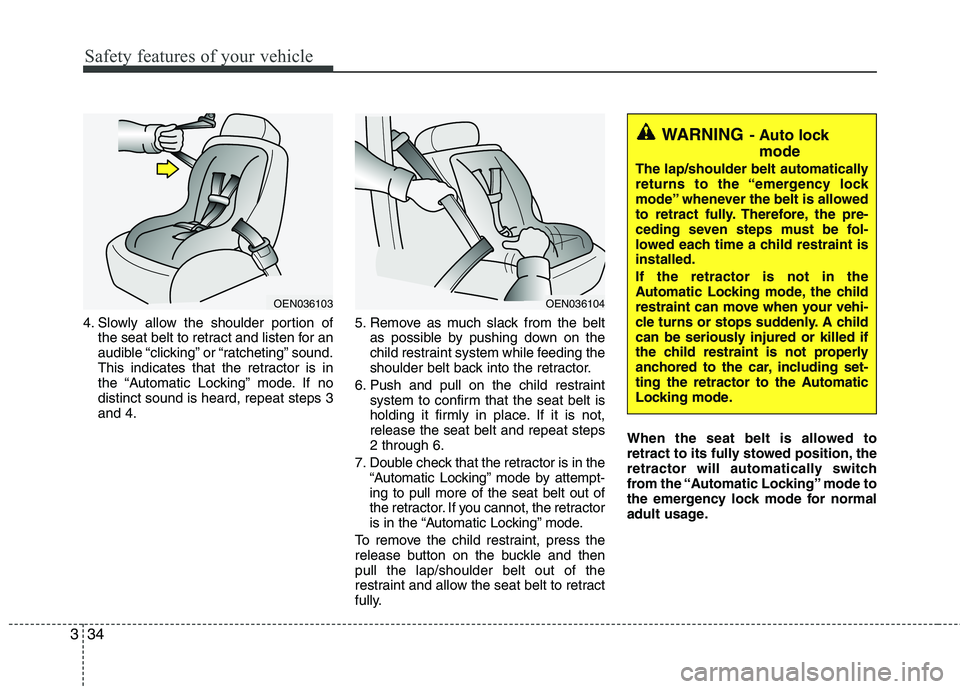
Safety features of your vehicle
34
3
4. Slowly allow the shoulder portion of
the seat belt to retract and listen for an
audible “clicking” or “ratcheting” sound.
This indicates that the retractor is in
the “Automatic Locking” mode. If nodistinct sound is heard, repeat steps 3and 4. 5. Remove as much slack from the belt
as possible by pushing down on the
child restraint system while feeding the
shoulder belt back into the retractor.
6. Push and pull on the child restraint system to confirm that the seat belt is
holding it firmly in place. If it is not,release the seat belt and repeat steps 2 through 6.
7. Double check that the retractor is in the “Automatic Locking” mode by attempt- ing to pull more of the seat belt out of
the retractor. If you cannot, the retractor
is in the “Automatic Locking” mode.
To remove the child restraint, press the
release button on the buckle and then pull the lap/shoulder belt out of the
restraint and allow the seat belt to retract
fully. When the seat belt is allowed to
retract to its fully stowed position, the
retractor will automatically switch
from the “Automatic Locking” mode to
the emergency lock mode for normal
adult usage.
OEN036104OEN036103
WARNING- Auto lock
mode
The lap/shoulder belt automatically
returns to the “emergency lock
mode” whenever the belt is allowed
to retract fully. Therefore, the pre-
ceding seven steps must be fol-
lowed each time a child restraint isinstalled. If the retractor is not in the
Automatic Locking mode, the child
restraint can move when your vehi-
cle turns or stops suddenly. A child
can be seriously injured or killed if
the child restraint is not properly
anchored to the car, including set-
ting the retractor to the Automatic
Locking mode.
Page 63 of 382
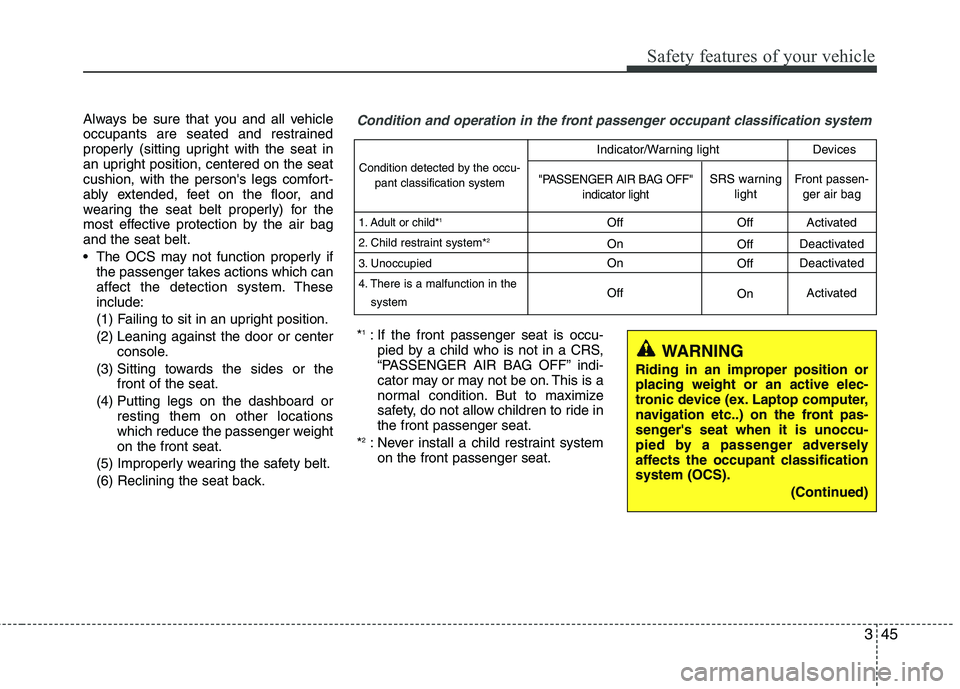
345
Safety features of your vehicle
Always be sure that you and all vehicle
occupants are seated and restrained
properly (sitting upright with the seat in
an upright position, centered on the seat
cushion, with the person's legs comfort-
ably extended, feet on the floor, and
wearing the seat belt properly) for the
most effective protection by the air bag and the seat belt.
The OCS may not function properly ifthe passenger takes actions which can
affect the detection system. These include:
(1) Failing to sit in an upright position.
(2) Leaning against the door or center console.
(3) Sitting towards the sides or the front of the seat.
(4) Putting legs on the dashboard or resting them on other locations
which reduce the passenger weighton the front seat.
(5) Improperly wearing the safety belt.
(6) Reclining the seat back.Condition and operation in the front passenger occupant classification system
* 1
: If the front passenger seat is occu-
pied by a child who is not in a CRS,
“PASSENGER AIR BAG OFF” indi-
cator may or may not be on. This is a
normal condition. But to maximize
safety, do not allow children to ride inthe front passenger seat.
* 2
: Never install a child restraint system
on the front passenger seat.
WARNING
Riding in an improper position or placing weight or an active elec-
tronic device (ex. Laptop computer,
navigation etc..) on the front pas-
senger's seat when it is unoccu-
pied by a passenger adversely
affects the occupant classification system (OCS). (Continued)
Condition detected by the occu-pant classification system
1. Adult or child*1
2. Child restraint system* 2
3. Unoccupied
4. There is a malfunction in the system
Off
On On
Off Off Off Off OnActivated
Deactivated
Deactivated
Activated
"PASSENGER AIR BAG OFF" indicator lightSRS warninglightFront passen-ger air bag
Indicator/Warning light Devices
Page 64 of 382
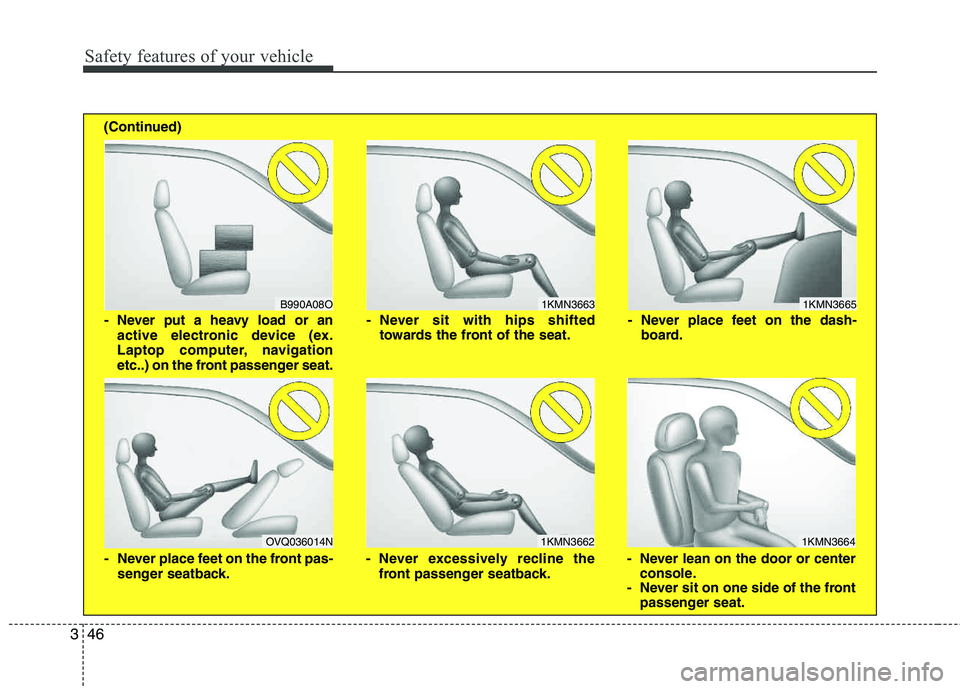
Safety features of your vehicle
46
3
1KMN3663
1KMN3664
1KMN3665
- Never sit with hips shifted towards the front of the seat.
- Never lean on the door or centerconsole.
- Never sit on one side of the front passenger seat.
- Never place feet on the dash-
board.B990A08O
1KMN3662
- Never put a heavy load or an
active electronic device (ex.
Laptop computer, navigation
etc..) on the front passenger seat.
- Never excessively recline thefront passenger seatback.OVQ036014N
- Never place feet on the front pas- senger seatback.
(Continued)
Page 75 of 382
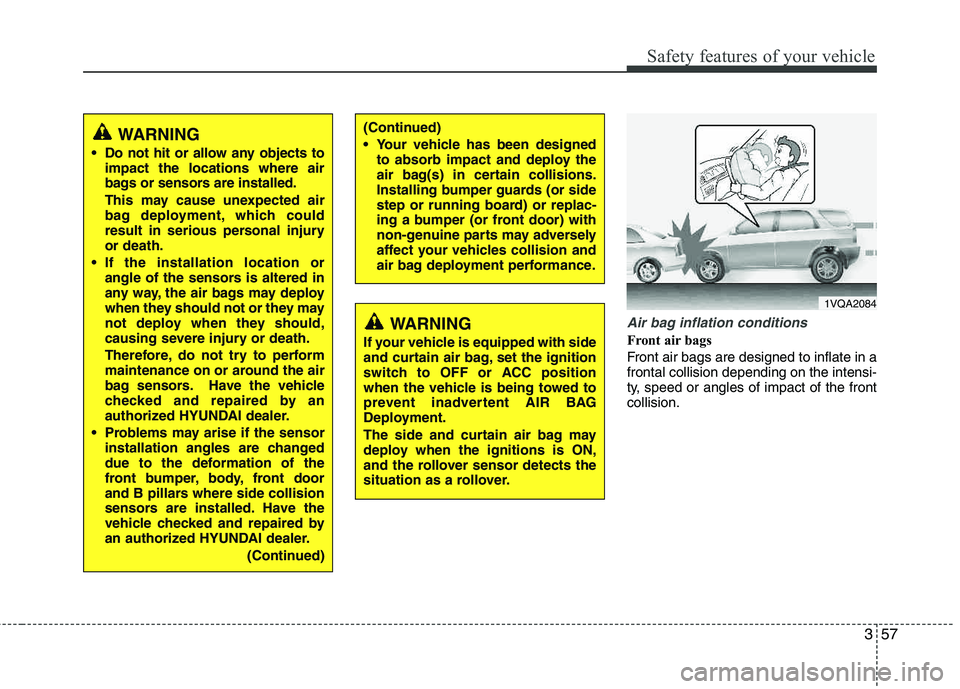
357
Safety features of your vehicle
Air bag inflation conditions
Front air bags
Front air bags are designed to inflate in a frontal collision depending on the intensi-
ty, speed or angles of impact of the front collision.
1VQA2084
WARNING
Do not hit or allow any objects to impact the locations where air
bags or sensors are installed.
This may cause unexpected air
bag deployment, which could
result in serious personal injury or death.
If the installation location or angle of the sensors is altered in
any way, the air bags may deploy
when they should not or they may
not deploy when they should,
causing severe injury or death.
Therefore, do not try to perform
maintenance on or around the air
bag sensors. Have the vehicle
checked and repaired by an
authorized HYUNDAI dealer.
Problems may arise if the sensor installation angles are changed
due to the deformation of the
front bumper, body, front door
and B pillars where side collision
sensors are installed. Have the
vehicle checked and repaired by
an authorized HYUNDAI dealer.
(Continued)(Continued)
Your vehicle has been designedto absorb impact and deploy the
air bag(s) in certain collisions.
Installing bumper guards (or side
step or running board) or replac-
ing a bumper (or front door) with
non-genuine parts may adversely
affect your vehicles collision and
air bag deployment performance.
WARNING
If your vehicle is equipped with side
and curtain air bag, set the ignition
switch to OFF or ACC position
when the vehicle is being towed to
prevent inadvertent AIR BAG
Deployment.
The side and curtain air bag may
deploy when the ignitions is ON,
and the rollover sensor detects the
situation as a rollover.
Page 76 of 382

Safety features of your vehicle
58
3
Side impact and curtain air bags
Side impact and curtain air bags are designed to inflate when an impact is
detected by side collision sensorsdepending on the strength, speed or angles of impact resulting from a side impact collision. Also, the side impact and curtain air bags
are designed to inflate when a rollover is
detected by the rollover sensor.
Although the driver's and front passen- ger's air bags are designed to inflate only
in frontal collisions, they also may inflate in other types of collisions if the front impact sensors detect a sufficient
impact. Side impact and curtain air bagsare designed to inflate only in side impact
collisions or rollovers. But they may inflate in other type of collisions or simi-
lar rollover situations, including when the
vehicle is tilted such as being towed if the
side impact sensors or rollover sensor
detect a sufficient impact or rollover.
If the vehicle chassis is impacted by
bumps or objects on unimproved roads,
the air bags may deploy. Drive carefully
on unimproved roads or on surfaces not
designed for vehicle traffic to prevent
unintended air bag deployment.
Air bag non-inflation conditions
In certain low-speed collisions the air
bags may not deploy. The air bags are
designed not to deploy in such cases
because they may not provide benefits
beyond the protection of the seat belts
in such collisions.
1VQA2086
OVQ036018N
OUN026090